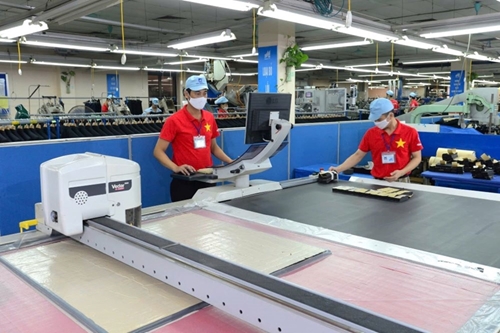Speeding up into upper-middle-income group
Heavily affected by the aftermath of war, post-1975 Vietnam was plunged into poverty, backwardness, and difficulties. Infrastructure was largely destroyed and the economy operated under a sluggish subsidy regime, with production mainly based on self-sufficient agriculture. Inflation at times soared to above 700%, people’s living conditions were extremely poor, and the average income per capita was only around 100 USD per year. Since the implementation of the Doi Moi (Renewal) reforms in 1986, Vietnam has gradually overcome its crisis and risen strongly, becoming one of the most dynamic emerging economies in the Asia-Pacific region.
Over the past three decades, Vietnam's gross domestic product (GDP) has grown at an average annual rate of about 6-7%, regardless of global challenges, including the COVID-19 pandemic and international economic fluctuations. By 2024, Vietnam’s economy had reached a scale of over 476 billion USD, ranking fourth in ASEAN, behind only Indonesia, Singapore, and Thailand. Vietnam is now among the world’s top 40 economies and ranks 32nd among the top 100 strongest national brands in the world.
    |
 |
|
Production activities at Garco 10 |
Fifty years on, the living standards of Vietnamese people have seen remarkable improvements. In the early 1990s, the poverty rate was 58%, but by 2024, the national multidimensional poverty rate had dropped to 4.06%. Vietnam's GDP per capita reached about 4,700 USD, officially placing the country in the upper-middle-income category.
One of the key pillars driving Vietnam’s economic growth is exports. With open-market policies, a favorable business environment, and an abundant labor force, Vietnam has become a magnet for foreign direct investment (FDI). Vietnam’s export turnover saw a spectacular rise - from less than 1 billion USD in 1986 to more than 400 billion USD in 2024.
Currently, Vietnam is among the world’s top 20 countries with the largest trade turnover and is recognized as one of the most open and deeply integrated economies in the region. This dramatic rise in trade not only reflects Vietnam’s manufacturing and export capacity and its integration into the global economy, but also the results of institutional reform, administrative simplification, the signing of new-generation free trade agreements (FTAs), and efforts to build a transparent and competitive business environment.
However, Vietnam continues to face significant challenges on its development path due to uneven development between regions, the gap between the rich and the poor, the pressure of aging population, climate change, low labor productivity compared to developed economies, and especially the requirements for green transition and sustainable development in an increasingly competitive global landscape.
New launcher
Vietnam has set a GDP growth target of 8% or higher in 2025 - significantly above the National Assembly’s official target of 6.5-7%. This figure not only reflects high expectations but also demonstrates a strategic vision and a strong aspiration for advancement as the country enters a new phase of development. The high growth target is seen as a significant step to create momentum for Vietnam to break through double-digit growth in the following stages.
To realize the growth target, the government has focused on renewing and strengthening traditional growth drivers and cultivating new ones. Among them, public investment is considered a key "stimulus lever." The government is prioritizing the efficient disbursement of public capital, especially for strategic transportation infrastructure projects. Regarding private investment, the government is committed to improving the business environment to maximize support for domestic enterprises while also attracting high-quality FDI. Priority is given to high-tech, innovative, green, and sustainable projects.
Meanwhile, to maintain strong export momentum, the government is actively assisting businesses in expanding markets through new-generation FTAs; making the most of global integration opportunities; placing emphasis on high value-added sectors such as high-tech industries, digital economy, and innovation; high-tech agriculture linked to green, sustainable exports; renewable energy, circular economy, and low-carbon economy; high-quality services, logistics, green tourism, and digital finance.
Vietnam is not just a country reborn after war. It is a symbol of resilience, creativity, and aspiration. From a country that was once besieged and embargoed, Vietnam has now established diplomatic relations with nearly 200 countries and territories, and actively participated in global and regional multilateral organizations. The image of a peaceful, cooperative Vietnam which has confidently moved forward on the path of prosperous and sustainable development is increasingly affirmed.
Translated by Quynh Oanh